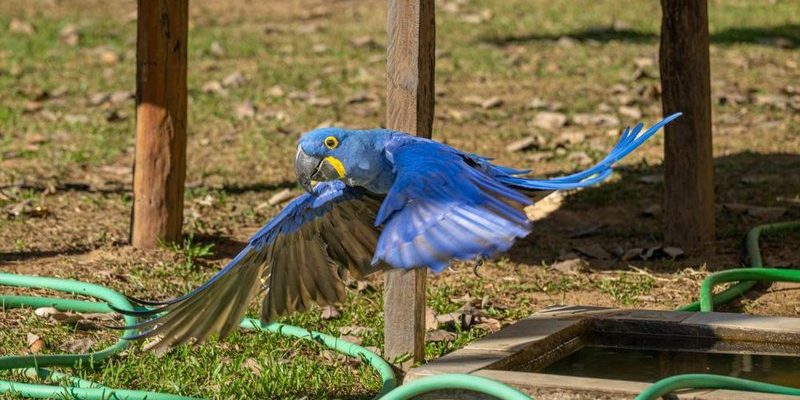
Imagine strolling through a lush, tropical forest where the air is thick with the sounds of chirping birds and rustling leaves. Suddenly, you spot a flash of blue soaring overhead. That’s our Hyacinth Macaw, a creature that’s not only a wonder of nature but also a symbol of the conservation challenges we face today. By understanding their status, we can appreciate what’s at stake and what we can do to help.
What Is the Current Status of the Hyacinth Macaw?
To grasp whether the Hyacinth Macaw is threatened or endangered, we first need to look at its current status. The International Union for Conservation of Nature (IUCN) lists the Hyacinth Macaw as Vulnerable, which means they are at risk of becoming endangered unless conservation efforts are made. They are not on the brink of extinction, but their population is decreasing, raising significant concerns.
You might wonder why this matters. Well, every time a species faces threats, it impacts the entire ecosystem. The Hyacinth Macaw plays a crucial role in seed dispersal, helping to maintain the health of the forests they inhabit. So, when we see their numbers drop, it’s not just about losing one bird; it could also mean losing a piece of our planet’s biodiversity.
What Are the Main Threats Faced by Hyacinth Macaws?
The biggest threats to Hyacinth Macaws come from habitat loss and illegal trapping. Their natural habitats, mostly found in Brazil, are being destroyed for agriculture and logging. As their homes vanish, so do the resources they rely on for food and nesting.
– Habitat Loss: Deforestation is a huge issue. Imagine being forced out of your home with nowhere to go. That’s the reality for many Hyacinth Macaws as trees are cut down to make way for farmland.
– Illegal Trapping and Trade: Sadly, these birds are often captured for the pet trade. People want the Hyacinth Macaw for its beautiful plumage and charming personality, but what they may not realize is that this demand fuels illegal activities that threaten their survival.
You might be asking, “What can be done?” Well, awareness is the first step, and supporting conservation efforts is vital.
How Many Hyacinth Macaws Are Left in the Wild?
Estimates suggest there are about 6,500 to 10,000 Hyacinth Macaws remaining in the wild, although this number can vary. That’s not a lot when you think about it, especially considering the vast areas they once roamed.
These numbers indicate that without immediate intervention, their future looks bleak. You can envision these birds like rare gems in a disappearing treasure chest; the fewer there are, the more precious each one becomes.
Why Are Hyacinth Macaws Important to Their Ecosystem?
The Hyacinth Macaw isn’t just a pretty face in the avian world. These birds play a crucial role in their ecosystem. They are considered “keystone species,” meaning their presence has a disproportionate effect on their environment.
– Seed Dispersers: By eating fruits and nuts, they help in spreading seeds throughout the forest. This activity is vital for plant reproduction, which in turn supports other wildlife.
– Biodiversity Indicators: The health of Hyacinth Macaw populations can indicate the overall health of their habitat. If they are thriving, chances are the ecosystem is balanced and thriving too.
You might not think about birds when considering ecosystem health, but every species has its part to play.
What Conservation Efforts Are in Place for Hyacinth Macaws?
Various organizations are working tirelessly to protect Hyacinth Macaws and their habitats. Strategies include habitat protection, rehabilitation efforts, and stricter regulations on trapping.
– Habitat Protection: By establishing protected areas and national parks, we can help secure a safe home for these birds.
– Education and Awareness: Organizations often conduct awareness campaigns to educate communities about the importance of the Hyacinth Macaw and the threats they face.
– Rescue and Rehabilitation: Many groups also rescue trapped macaws and provide rehabilitation, helping them return to the wild when possible.
You might be wondering how you can help—supporting these organizations through donations or spreading awareness can make a big difference!
How Can You Help Hyacinth Macaws?
While it may feel overwhelming to think about the plight of the Hyacinth Macaw, there are actually plenty of ways you can help. It doesn’t take a lot of time or money to make a difference.
– Support Conservation Organizations: Consider donating to or volunteering with groups dedicated to the protection of Hyacinth Macaws. Every little bit helps!
– Spread the Word: Awareness is powerful. Talk about the Hyacinth Macaw and share information on social media. The more people know, the greater the chances for change.
– Be a Responsible Pet Owner: If you’re thinking about getting a bird, consider adopting rather than buying. This helps reduce the demand for wild-caught birds.
In the digital age, sharing information can create ripples of change that benefit not just the Hyacinth Macaws but many other species threatened by the same issues.
The Hyacinth Macaw is indeed considered vulnerable, teetering on the edge of becoming endangered. But there’s hope. By understanding the challenges they face and the importance of their role in the ecosystem, we can take meaningful action. If we each do our part—through conservation, education, and responsible choices—we can help ensure that future generations will still get to marvel at the breathtaking beauty of these magnificent birds. Let’s join hands for a future where the skies are painted blue with the vibrant flight of the Hyacinth Macaw.

